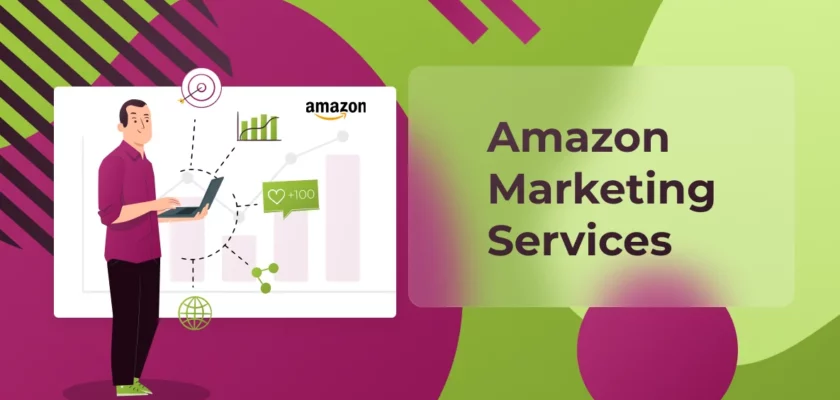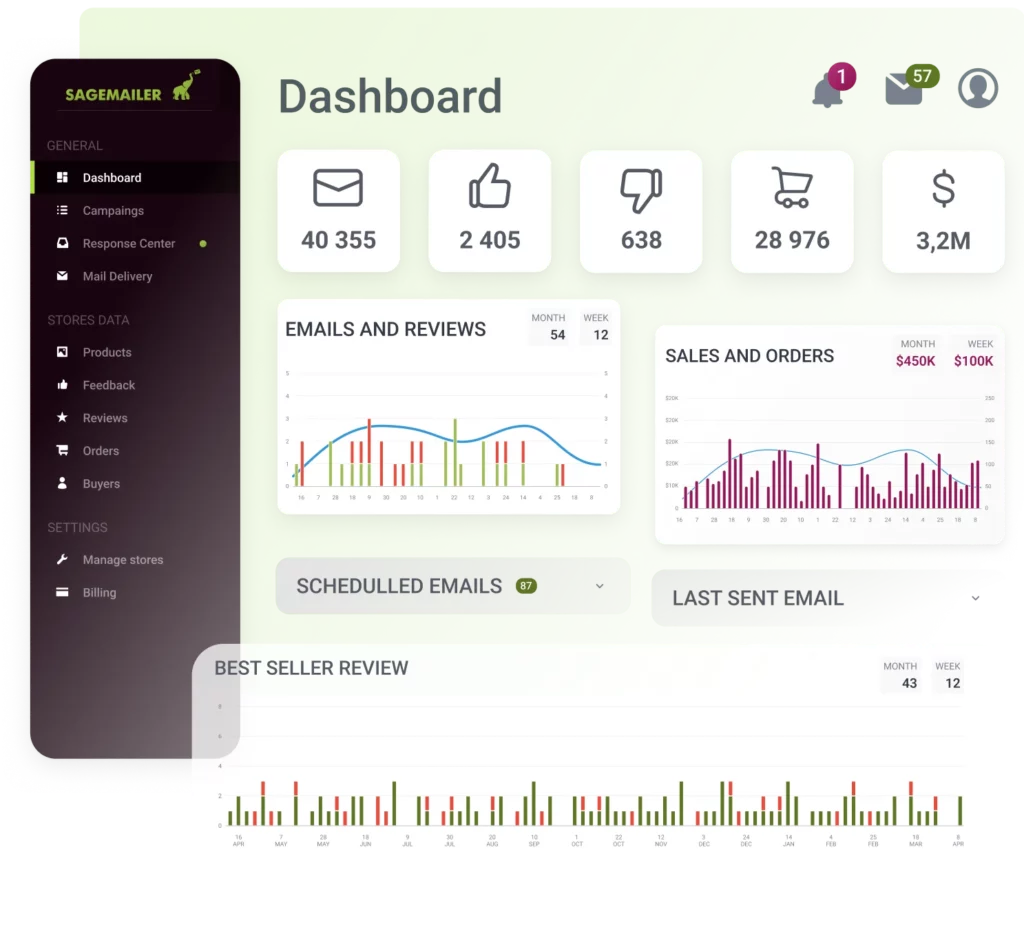Table of Contents
- 1 What Is AMS (Amazon Marketing Services)?
- 2 Types of Advertising Campaigns in AMS
- 3 Utilizing Keyword Types Effectively in AMS
- 4 Advantages of Incorporating AMS into Your eCommerce Business
- 5 Strategies to Build an Effective AMS Ad Campaign
- 6 Boost Your Advertising Campaigns with SageMailer
- 7 Requirements and Qualifications for AMS Ad Campaigns
- 8 Conclusion
According to Bloom Reach, the number of product searches has doubled on Amazon compared to Google. In addition, it influences 63% of marketers to increase their advertising budgets on Amazon E-commerce ads.
Initially launched in 2012, Amazon Marketing Services (AMS) has already undergone a flurry of development and modifications. Today, many vendors selling on Amazon have transitioned into using this AMS advertising platform. Based on a 2022 survey, fifteen percent of brand marketers are now using AMS to advertise their products. However, the steady activities in this platform indicate that more and more sellers are utilizing AMS marketing. So, what is AMZ (Amazon Marketing Services)? How to use Amazon Marketing Services (AMS)? Let’s dive in!
What Is AMS (Amazon Marketing Services)?

What are Amazon Online Marketing Services? First, let’s find out more about AMS’s meaning. AMS provides valuable tools that can assist Amazon vendors in selling products to drive traffic and produce efficient product advertising. In simple terms, it is an Amazon PPC, or relevant visitors can view a pay-per-click platform wherein products are through keywords and shopper interest. However, a click does not indicate a purchase. Thus, it is important to understand and learn how to leverage the platform to its potential.
Looking to boost your Amazon ad campaigns while making the most out of your budget? In this video, we’ll share top tips for optimizing your Amazon ads.
Types of Advertising Campaigns in AMS
Amazon offers three AMS (Amazon Marketing Services) campaigns where vendors can pick out particularly targeted ads. These campaign ads include Amazon Sponsored Product Ads, Amazon Product Display Ads, and Amazon Headline Search Ads. These AMS ads are being operated through the Amazon Advertising Platform (AAP) and are incorporated in various formats, e.g., display ads, mobile banner ads, etc.
Sponsored Product Ads
These campaigns will allow you to establish a daily budget and let you determine your keyword targeting options. Then, as a vendor, you can decide on the products you want to market and advertise. To optimize these campaigns, you should be able to utilize the search queries and keyword suggestions.
These ads are either manual (keyword-driven) or automated (content-driven) targeted campaigns that appear on the search engine results page’s right and bottom or top rail. Generally, they are considered a middle-of-the-funnel campaign since they come out in locations where customers are likely to consider various options for purchase. In addition, sponsored Product Ads are also popular since it is available to both first-party vendors and 3P sellers.
Headline Search Ads
Here, you must determine and select a certain ad landing page to advertise your products. Like Sponsored Search Ads, these campaigns are also being run by keyword targeting. Again, the seller will have to set a budget for the campaign with a minimum of $100. Under this, you can put a single product image and a headline in the ads.
These ads are keyword-driven, which accompanies a manual targeting strategy. It appears at the top of the search engine results page (SERP). Headline Search Ads are only accessible and available to Amazon first-party vendors.
Product Display Ads
For these campaigns, the seller must determine whether a certain product or a general interest will be targeted. How much does Display Amazon Marketing Service charge? The overall campaign will require a budget of at least $100. The Ad campaign will allow you to add a logo and a headline to make it more appealing. These ads demand less creativity than Amazon Headline Search Ads since most of the content of these ads is generally populated with product listings. A box where your ad can be seen in the related product section is also available. In the box section, you put your product on other items that are not entirely similar to the one you are advertising.
Product display ads are unique since marketers must depend on Interest-based Targeting or Product Targeting Options.
The interest-based targeting is a method used to target an audience of buyers who share their interest in what you are offering. Usually, it would result in a higher volume but a lower conversion rate. It is because these ads target and focus on shoppers who may have purchased your offered products in the past.
Product targeting, however, allows marketers to become more granular, resulting in a higher conversion rate. Ultimately, it is important to do A/B testing to determine which one is satisfactory for you.
One of the major benefits of all these AMS advertising campaigns is that you will only have to pay per click. If a shopper scrolls past your ad, you will not be required to spend a sum. However, you want your ad to be visited to drive conversion. To do this, you must optimize your ad so that clicks will turn into purchases.

Utilizing Keyword Types Effectively in AMS
One of the primary benefits of investing in Amazon PPC campaigns is that you can encounter buyer search queries and identify which searches would lead to sales. Thus, if you are running pay-per-click campaigns, you must study and learn Amazon’s marketing strategy to increase conversions further.
You need to incorporate keywords to get more visitors and shoppers to discover your Amazon ads. Using the best keyword for your Ad copy is important since it is a word people would search on Amazon. There are several ways that you can utilize a keyword. First, there is the single-term search keyword wherein only a single word is incorporated. You can also have the multiple phrases term search where the series of words are under a particular order. Other types of keywords for you to check include the following.
Complementary product keywords
These keywords refer to an item used in conjunction with the particular product you are marketing. For instance, if you are trying to sell ink cartridges, you will choose “printers” as one of your keywords. In this case, a shopper wanting to purchase a printer would perhaps be interested in buying the ink cartridges. It, in turn, can help drive traffic and demand.
Out-of-category keywords
It is when you use a keyword that is not related directly to the product you are trying to market and sell. Instead, it is a keyword that aims to point out a particular field where the product keyword seems to be relevant to them. This way, you can gather potential customers who generally would not check out a product independently.
Branded product keywords
Keywords that utilize your brand name belong to this category. It may come up in a variation. For example, if your brand’s name has the term “the” with it, you are allowed to eliminate that word and have a single keyword instead. Because of this, people who may search for a similar word to your brand name will be able to view your ads.
Competitor branded keywords
These are keywords that your competitors also use. You may want to implement similar keywords as them. It is helpful, especially if that competitor is equally or more popular than your brand.
Sponsored Products automatic targeting keywords
These are successful search queries and keywords from your automated targeted ad campaigns.
An effective ad campaign will utilize a combination of these keywords as it improves a wider chance of discoverability.
Advantages of Incorporating AMS into Your eCommerce Business
The main idea behind running an ad campaign is to achieve a set of goals that grow your business. For this, we usually set a few objectives and a budget to not exhaust our money and resources. You can take advantage of Amazon PPC campaigns in the following ways.
How AMS creates delightful shopping experiences
With millions of brands competing on Amazon, you must make your brand stand out. So you need to create delightful shopping experiences for your customers, and Amazon marketing services will definitely help!
Getting insights and optimizing product listings with AMS
A well-optimized product listing has higher conversion rates. Higher sales lead to better reviews and better ranking. Identify top-converting keywords with lower ACoS (advertising cost of sale) from your ad campaigns and target them in your listings. Improve the core pillars of your listings – product title, description, and question and answers. This attracts a loyal customer base.
The convenience offered by AMS
Customers have little control over the information they get from you. As an advertiser, it is your responsibility to offer more convenience to your customers. Perhaps, your top-selling proposition is the convenience you offer. Creating unique stores, landing pages, and easy return policies makes their life easier. This boosts the shopper experience.
Strategies to Build an Effective AMS Ad Campaign
AMS (Amazon Marketing Service) presents a powerful platform for advertising products on the world’s largest online marketplace. To harness its full potential, it’s imperative to employ strategies that not only optimize ad spend but also maximize return on investment (ROI). Below we outline two key pillars in creating a successful AMS ad campaign.
Understanding bid strategies for AMS
In the realm of Amazon online advertising services, effective bid management is the linchpin for campaign success. Manual bidding provides precise control over your spending, allowing you to set maximum amounts for each click. Consider factors like keyword relevance, competition, and anticipated ROI when determining bids.
Experiment with bid adjustments for different elements such as device types, times of day, and ad placements. For instance, you may increase bids for mobile users or specific placements with proven higher conversion rates.
Amazon further offers dynamic bidding options, automating bid adjustments. ‘Bid down for clicks’ conserves the budget by lowering bids when a conversion is less likely, while ‘bid up for conversions’ aims for higher placement and visibility when a conversion is more probable.
Creating a highly targeted Sponsored Product ad campaign
Crafting a highly targeted Sponsored Product ad campaign is essential for reaching the right audience and maximizing conversions.
Start by conducting thorough keyword research. Identify high-performing search terms that are relevant to your products. Incorporate these keywords strategically into your product titles, bullet points, and descriptions to enhance visibility in customer searches.
The visual aspect of your ad is equally important. Use high-quality images that clearly depict your product. Include multiple angles, close-ups, and lifestyle images if applicable. High-resolution images not only grab attention but also instill confidence in potential buyers.
Compelling ad copy is crucial for convincing potential customers to click. Craft clear, concise, and persuasive headlines and descriptions. Highlight key features, benefits, and unique selling points of your product.
Consider A/B testing different ad variations to identify what resonates best with your audience. Test different headlines, images, and call-to-action phrases to determine which combinations yield the highest click-through and conversion rates.
Utilize the full range of targeting options available in Amazon AMS ads. Keyword targeting ensures your ad is shown to customers actively searching for products like yours. Product targeting allows you to display your ad on related product detail pages, capturing customers’ attention browsing similar items. Audience targeting helps you reach specific customer segments based on behavior, interests, or demographics.
Optimizing your landing page is equally crucial. Ensure the page is directly relevant to the ad, providing a seamless transition for the customer. The landing page should offer clear product information, easy navigation, and a straightforward purchasing process. Additionally, prioritize fast loading times and mobile responsiveness to enhance user experience.
Regular monitoring and analysis are essential for the ongoing success of your AMS campaigns. Keep a close eye on key performance metrics like click-through rate (CTR), conversion rate, and return on ad spend (ROAS). Use this data to adjust your bidding strategies, ad content, and targeting options.
Boost Your Advertising Campaigns with SageMailer
Customer feedback is the lifeblood of successful advertising. It provides essential insights into consumer preferences and helps advertisers refine their strategies. Understanding and leveraging customer feedback management tools like SageMailer can help you craft effective ad campaigns in this competitive landscape.
- Monitor and analyze feedback in real-time
Sagemailer allows you to track customer feedback in real time across all Amazon Marketplaces. By analyzing the feedback received, you can identify specific areas where your advertising campaign may be falling short. This could include issues with messaging, targeting, or the overall customer experience.
- Address customer concerns promptly
Timely responses to customer feedback are crucial for maintaining a positive brand image. SageMailer sends instant notifications whenever you receive a new question, customer review, or inquiry. With its Response Center, you can easily respond to your clients by creating your own customer service letters for all typical inquiries and choosing the one that suits the use case.
- Request reviews from satisfied customers:
Sagemailer can automate the process of requesting reviews from satisfied customers. This can help boost your overall ratings and improve your brand’s reputation. Furthermore, with our tool, you can not only manage negative feedback by getting an instant notification. You can also automatically stop sending your emails to dissatisfied buyers until you solve the issue.
- Optimize ad spend
By understanding which aspects of your advertising campaign resonate with customers and which do not, you can allocate your ad spend more effectively. It ensures you get the best return on investment (ROI) from your advertising efforts.
Ready to try? Register for a free 30-day trial to explore its features.
Requirements and Qualifications for AMS Ad Campaigns
While all ad campaigns are available to Amazon vendors, it does not indicate that you can run them promptly without fulfilling Amazon’s requirements. In addition, each campaign has its specific requirements before you can utilize them.
Meeting the necessary requirements for AMS
For Amazon Sponsored Products Ads, you are required to have an active account on Amazon Professional Sellers. Your ability to make shipments to all U.S. locations will also be needed. In regards to your product, it needs to be brand new to make it eligible in the product listings. Approved listings are eligible for Buy Box. If your product listings are not qualified for the Buy Box, Amazon will not display your Sponsored Product Ad to buyers. Ads not qualified and eligible are flagged under Seller Central’s advertising tab in Campaign Manager. Currently, these ads are only available in limited countries. These include China, Spain, Italy, France, the UK, Germany, the U.S., and Canada.
Headline Search Ads and Product Display Ads are only accessible and available to Amazon sellers. You must provide your custom headline and product image for AMS headline ads. At the same time, vendors who will apply for Product Display Ads need to issue their logo and headline.
How to qualify for AMS on Amazon?
While internet marketing like AMS provides open opportunities, it is available only to those who meet the requirements. For safety and authenticity purposes, vendors with approved Amazon accounts are the only ones eligible to make a transaction in AMS. To be approved, you will be required to meet one of these credentials to gain admission.
- Kindle Direct Publishing account
- Advantage Central login
- Vendor Express login
- Vendor Central login
Most sellers consider Vendor Express as the most direct and uncomplicated method. With Vendor Express, anyone in the program can access AMS.
Conclusion
One of the most beneficial and effective methods of promoting your product with relevant Amazon customers is through Marketing Services on Amazon. Many companies and individual vendors have experienced success with this platform. By following the best and correct practices, your brand will have a profitable presence in one of the most powerful online marketplaces in the world.
When marketing your Amazon services, it will not hurt to use tools like SageMailer in order to gain more sales and improve your online reputation. You can try SageMailer’s free 30-day trial to see the immediate result!


